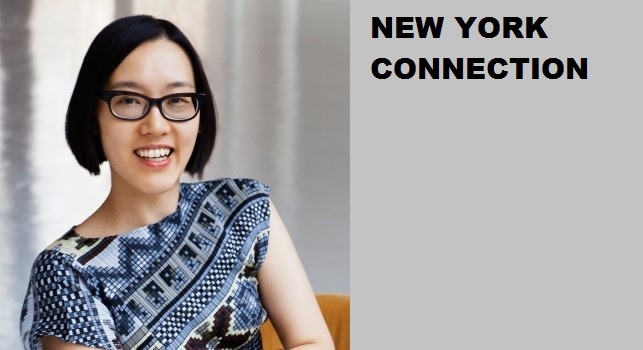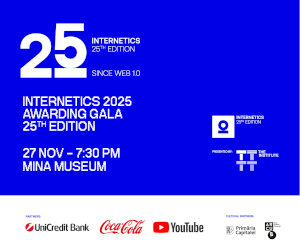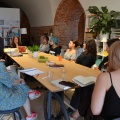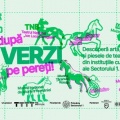Christine Kuan started her career at the Metropolitan Museum of Art in New York, she led the development of artsy.net, the visionary platform aiming to “make art as ubiquitous as music” and is now leading the New York campus of Sotheby’s Institute of Art, the most prestigious institution preparing professionals for all sectors of the art market.
How did you become interested in the art world, in New York, what inspired you, where did it all start?
Since I was a kid, I was very passionate about art, and my family took me to many art museums and historical homes. Also, my grandfather was a painter, and though I never met him, there was a lot of art and artistic activity in my home. Growing up in New Jersey, I always felt that New York City was the liveliest place for artists and cultural excitement, so it’s natural that I’ve ended up working here for nearly 20 years.
How was life working at The Metropolitan Museum of Art? What about Artsy?
The Metropolitan Museum of Art is the most majestic, wonderful, magical place and working there was a privilege and a huge learning opportunity. Even though I was not very senior in the museum, I learned how major institutions are governed and how serious curatorial work gets carried out. Moving from an institutional background to Artsy was a massive transition, but I learned so much about technology, being agile in a very competitive art market, and how teamwork and communication can really change the dynamics of the workplace. I met many of my closest friends at Artsy - it’s an intense place that has succeeded as a result of all the love, talent, and dedication of its team members.
Did you have a mentor along the way, someone to influence and guide you through your career? How does being a woman influenced your path? What were the key sources of support or resistance you encountered?
When I was in college I consulted my art history professor in Asian art about pursuing a PhD in art history, and she said, “Don’t! It’s a life of suffering!”. So in a way, that was my mentor because she steered me into all the other possibilities of working with art. Obviously, if art historical research is your passion, you should pursue a PhD. But if you want to be active in the art market, there are so many other pathways, and I think the Sotheby’s Institute of Art prepares our students for those various career options.
In many major museums and companies, the people at the very top are still white men. Being a Chinese-American woman in the art world requires you to be thoughtful about navigating political and social mores. You have to find a way to excel in the industry by building allies, delivering exceptional results, and developing your own reputation for a person of integrity, intelligence and capability. In the early days of my career, I thought you had to be aggressive to get results, but now I realize you can accomplish even more by being softer. As the saying goes, "You catch more flies with honey". It’s the truest thing in business and in life.
I think every business is desperate for leadership and talent. If you are great at what you do, the resistance falls away - you will have supporters. I have been very lucky to have supporters and believers at every step of my career.
THE Institute is now preparing Diploma, an exhibition showcasing the best graduation projects of art school students from across Romania, and they all will be reading this. What is your advice for young artists, how can they make themselves be heard, what tools should they use?
I think technology is a very powerful medium to reach new audiences and to reach the public. Young artists to take advantage of many of the free social media platforms to showcase their work and to promote their work. I know many gallery friends who have discovered new artists on social media, and many collectors who have bought work via social media. So many traditional barriers - geographic, economic, and social - have been eroded by technology. It’s a great time to be an artist.
Tell us about Sotheby's Institute of Art, the Summer and Online courses and also tell us about the amazing Master’s Degrees. Who should apply, at what stage of their career? What is the relationship between Sotheby’s Institute of Art and the Auction House?
The Institute was founded by the auction house in 1969 as a training program to prepare art professionals for working in the auction house. The Institute is now the first and foremost graduate school for the study of art and its markets. Today, we are a separate institution from the auction house, but we have very close ties to the auction house and still hold our student orientations and graduation ceremonies there.
The MA program is for people who know they want to work in a professional capacity in the art world. We are focused on providing the best possible professional training and academic education for having careers in the art market - galleries, art fairs, and auction houses. Through classroom lectures, behind-the-scenes industry access, and intensive field study in international venues, we give our graduates a 360 degree view of the art market with a depth and breadth that is unparalleled. Our 6,000 alumni hold leadership position in all sectors of the art world, including in museums, foundations, publishing houses, and other nonprofit and commercial art businesses. Many of our MA students go on to found their own businesses and have a very entrepreneurial spirit.
Our summer and online courses provide exceptional classes for people who want to dip a toe in the water before they dive into an MA, or for those who want to strengthen certain areas of knowledge for themselves personally or professionally. We have extraordinary art historians and industry experts teaching in our MA, summer, and online courses. It’s the kind of insider information that is very difficult to obtain through traditional educational programs, or through publications and media sources alone.
How does a typical day at work look for you? How does your agenda look for the next months, what upcoming projects are you most excited about?
I’m most excited about the reopening of our New York campus after extensive renovations and expansion. We are going to have a brand new student cafe, an expanded library, and new gallery spaces for student curated shows. We are entering a new era of growth for the Institute, and the day to day is filled with academic meetings, strategic partnership discussions, and exciting conversations with the students about how we continue to expand their career opportunities in the art market.
What is the most important aspect of your work? What are the goals you most want to accomplish in your work? Not so much the goals that are in your job description, but the goals you hold personally?
I believe that when we work as art professionals in the art world, we are stewards of art and culture. In a time of increasing turmoil in the world, I believe art provides people with a connection to the best of humanity. So for me, directing the Sotheby’s Institute of Art, New York, means we are doing the important work of fostering future generations of art professionals who will encourage the collection, preservation, and conservation of art and culture. My personal mission is to assert the value of art, not only in the marketplace, but also in our culture, and I am very honored to have this role where I can work with extremely talented faculty and staff to help young people develop careers in this dynamic and meaningful field.






















